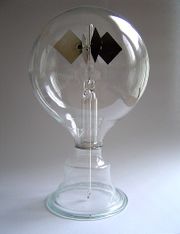Heat Radiation - Infra Red Radiation
It is sometimes called 'heat radiation'. The transfer of heat energy by radiation does not need matter particles to pass on the energy as the photons of energy can travel across a vacuum. All matter constantly releases and absorbs radiant energy. Infra red photons are released when 'electrons jump to a lower enegy level orbital' and are absorbed making 'electrons jump to a higher energy orbital'. If the body is of a lower temperature than its surroundings it absorbs more than it emits - raising its temperature and vice versa. A body at constant temperature is absorbing radiation at the same rate as it is emitting radiation. The temperature of a body increases when the body absorbs radiation faster than it emits radiation. Hotter matter is able to release higher frequency radiant energy than cooler matter - as its electrons get promoted to higher energy levels. The radiant energy can be looked at as either a stream of particles (photons) or as a wave - the 'things waving' are the electric and magnetic fields the photon generates as it moves, not matter particles. Think about standing in front of a bonfire
When you stand in front of a bonfire you feel the warmth of the fire on your hands and face. If you move back several feet away you can still feel warmth - but less intensely. It is the radiant energy that you feel - infra red rays coming off the fire travelling like invisible light rays towards you. Your skin then absorbs the rays and you feel warm. If someone moves in front of you, you suddenly notice the difference. The persons body is blocking the radiant energy from reaching you - you are in their shadow. A body at constant temperature is absorbing radiation at the same rate as it is emitting radiation. But its temperature increases when it absorbs radiation faster than it emits radiation. So when you heat an object it begins to give off a detectable amount of energy called infra red electromagnetic radiation - we say it is emitting heat. At low temperatures the emitted radiation is confined to the infra-red region of the spectrum. If you continue to heat the object to a really high temperature eventually you can see some of the radiation - visible e.m. radiation. The waves have reached a frequency which our eyes can detect as light. The logs on the bonfire have reached the temperature necessary for this to happen. Heat energy will move from warm to cold areas.The warm surface could be more than 300° C like the surface of the logs in the fire or it could be 40°C like the surface of the warm radiator in your comfortable heated home. Both will emit 'heat rays' - infra red rays and absorb them. But the hotter object will emit more per second than the cooler one - the hotter the object is compared to its surroundings the faster it will radiate the heat (more J/s).Reflection of Infra Red RadiationThe physical qualities of an object also determine the ability of the object to absorb or reflect radiation.The surface properties of materials (their emissivity) also affects the amount of heat radiated. Two objects at the same temperature, and the same size do not necessarily radiate the same amount of heat..... the darker, rougher, duller one would emit the most heat per second because as a rule, dull, rough surfaces absorb radiant heat very well, they therefore are easily heated by radiation. Smooth polished surfaces are usually good reflectors that do not hold heat efficiently. Objects that absorb heat well, will also emit heat well. Objects that reflect heat well, often emit heat poorly.
How a Crookes radiometer works The radiometer consists of a glass bulb, from which much of the air has been removed to form a partial vacuum. Inside the bulb, on a low friction spindle, are several (usually four) lightweight metal vanes. Each vane is polished on one side, and blackened on the other. In sunlight, or exposed to a source of infra-red radiation (even the heat of a hand nearby can be enough), the vanes turn with no apparent motive power. Heat radiation excites the black surface of the vanes more than the white surface. This is because black is a good absorber and a good radiator of heat and white is a poor radiator and absorber of heat.
|
Follow me...
|


 Infra red radiation is part of the
Infra red radiation is part of the 
 Infra-red cameras, night vision and thermography - click here
Infra-red cameras, night vision and thermography - click here The Crookes radiometer was invented by the chemist Sir William Crookes as the byproduct of some chemical research. In the course of very accurate quantitative chemical work, he was weighing samples in a partially evacuated chamber to reduce the effect of air currents, and noticed the weighings were disturbed when sunlight shone on the balance. Investigating this effect, he devised the device named after him, still manufactured and sold to this day as a curiosity item.
The Crookes radiometer was invented by the chemist Sir William Crookes as the byproduct of some chemical research. In the course of very accurate quantitative chemical work, he was weighing samples in a partially evacuated chamber to reduce the effect of air currents, and noticed the weighings were disturbed when sunlight shone on the balance. Investigating this effect, he devised the device named after him, still manufactured and sold to this day as a curiosity item.


